The Passage Forward 5
Combining Gods creation with history, known science and historical facts that exist in the 'material' world.
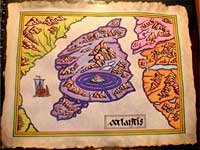 Etymologists
have shown that the story of the Garden of Eden in the book
of Genesis may be the story of an Island Paradise called
Atlantis .
Some believed that the birthplace of civilization was in the
land of Sumer. It is said to be in the 'land between two rivers',
which was in Mesopotamia and is composed of the two rivers that
flow into the Persian Gulf. In any event it has been shown to be
in northwest Asia. Iran is where the two rivers split and it is
the site of the Tower of Babel built by the Son's of Noah,
Namely Nimrod.
Etymologists
have shown that the story of the Garden of Eden in the book
of Genesis may be the story of an Island Paradise called
Atlantis .
Some believed that the birthplace of civilization was in the
land of Sumer. It is said to be in the 'land between two rivers',
which was in Mesopotamia and is composed of the two rivers that
flow into the Persian Gulf. In any event it has been shown to be
in northwest Asia. Iran is where the two rivers split and it is
the site of the Tower of Babel built by the Son's of Noah,
Namely Nimrod.
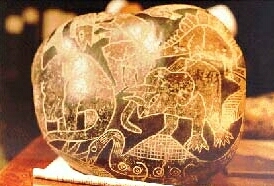 In the Peru desert Ocucaje, Dr. Javier Cabrera discovers
40,000-50,000 rock engravings which show step-by-step a heart
transplant and Caesarean section surgery. They also showed
dinosaurs and men riding them. These men were shorter and had
larger heads than modern man. Some of the dinosaur depictions show
people living with dinosaurs, and using dinosaurs for labor.
Click the link and see several
other pictures of Ica Stones containing dinosaurs. see..
the Ica Stones
of Peru. Also see the Sphinx Group below and
Archeological findings
In the Peru desert Ocucaje, Dr. Javier Cabrera discovers
40,000-50,000 rock engravings which show step-by-step a heart
transplant and Caesarean section surgery. They also showed
dinosaurs and men riding them. These men were shorter and had
larger heads than modern man. Some of the dinosaur depictions show
people living with dinosaurs, and using dinosaurs for labor.
Click the link and see several
other pictures of Ica Stones containing dinosaurs. see..
the Ica Stones
of Peru. Also see the Sphinx Group below and
Archeological findings
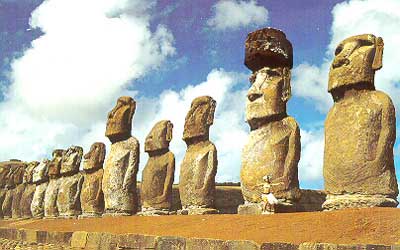 Then we have the Easter Island Moais stones. It is one of the
most isolated islands in the world but 1200 years ago a
double-hulled canoe filled with seafarers from a distant
culture landed upon its shores. Over the centuries that followed
a remarkable society developed in isolation on the island.
For reasons still unknown they began carving giant statues
out of volcanic rock. These monuments, known, as "moai"
are some of the most incredible ancient relics ever discovered.
The people of Easter Island called themselves the Rapa Nui.
Where did they come from and why did they disappear?
Science has learned much about the enigma of Easter Island
and has put to rest some of the more bizarre theories, but
questions and controversies remain.
Easter Island
Explore this site to get the latest information on the island's history and
current research. Easter Island, which lies on the Nazca Plate close to the
East Pacific Rise, is moving eastward toward South America by seafloor
spreading at the fastest rate known in the world. USGS
Then we have the Easter Island Moais stones. It is one of the
most isolated islands in the world but 1200 years ago a
double-hulled canoe filled with seafarers from a distant
culture landed upon its shores. Over the centuries that followed
a remarkable society developed in isolation on the island.
For reasons still unknown they began carving giant statues
out of volcanic rock. These monuments, known, as "moai"
are some of the most incredible ancient relics ever discovered.
The people of Easter Island called themselves the Rapa Nui.
Where did they come from and why did they disappear?
Science has learned much about the enigma of Easter Island
and has put to rest some of the more bizarre theories, but
questions and controversies remain.
Easter Island
Explore this site to get the latest information on the island's history and
current research. Easter Island, which lies on the Nazca Plate close to the
East Pacific Rise, is moving eastward toward South America by seafloor
spreading at the fastest rate known in the world. USGS
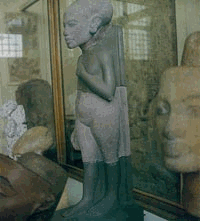 Human footprints found in same layer as dinosaur prints in Glen
Rose, Texas. These were called "giant man tracks" and would seem
to coincide with the bible's mention of the fallen angles being
large size and roaming the earth in the times of Noah. See
Paluxy, Glen Rose, TX. Large men were also mentioned when Moses
led the Israelites to Canaan. More fossillized man tracks
were discovered near Tuba City, Arizona.
Human footprints found in same layer as dinosaur prints in Glen
Rose, Texas. These were called "giant man tracks" and would seem
to coincide with the bible's mention of the fallen angles being
large size and roaming the earth in the times of Noah. See
Paluxy, Glen Rose, TX. Large men were also mentioned when Moses
led the Israelites to Canaan. More fossillized man tracks
were discovered near Tuba City, Arizona.
But the Texas time period is not the oldest. It only reflects what
was known about our origins before archaeological science began
to discover much older evidence of mankind. Science has
uncovered much evidence of an advanced civilization. More
evidence lies under water, yet to be investigated.
Many believe Atlantis lay in the Atlantic Ocean off the Azores, between the
United States and Africa. When
Vesuvius
( Italy in Campania on the Bay of Naples )'blew up' Atlantis sank.
(An eruption is recorded in 11,400 BP called, "Lagno Amendolare" Plinian (?) eruption.
see Eruptions before A.D. 79
But there are four more recorded before that.
(1) 25,000 BP "Codola" Plinian eruption
(2) 22,500 BP "Sarno" Plinian eruption
(3) 17,000 BP "Basal" Plinian eruption
(4) 15,500 BP "Greenish" ("Verdoline") Plinian eruption
Larger Map Middle East Map
Since we have some evidence that the human population
was destroyed at least three other times, we connect
these with the Vesuvius eruptions. Plato connects this 11,400 BP eruption
with the last destruction of Atlantis ( his date 10,000 BP ) and
Cayce on Atlantis
tells us this also;
"From time as counted in the present we would turn back to
10,600 years before the Prince of Peace came into the land
of promise, and find a civilization being disturbed by
corruption from within to such measures that the elements
join in bringing devastation to a stiff-necked and adulterous people".
According to Edgar Cayce, Atlantis extended from the Sargasso Sea to the Azores, and was about the size of Europe. It had experienced two periods of destruction, in the first of which the mainland had divided into islands. The final breakup occurred, as Plato said, about 11,600 BCE, and the last place to sink was near the Bahamas. He claimed that archives dealing with Atlantis now exist in three places in the world. One is in South America and one is in the Great Pyramid of Egypt. In June 1940 Cayce predicted that the island called Poseidia would rise again, "expect it in ‘98 or ‘99." It would happen in the area of the Bahamas.
 We also found more on the subject in
Isis Unveiled by the Russian occultist Helena Blavatsky, who had
dashed off its fifteen hundred pages at a speed that suggests
automatic writing. But her comments on Atlantis occupy only one
single page of Volume One (593), in which she explains that the
inhabitants of Atlantis were the fourth race on earth, and that
they were all natural "mediums." Having acquired their knowledge
without effort, this people was an easy prey for "the great and
invisible dragon" King Thevetat, who corrupted them so that they
became "a nation of wicked magicians." They started a war which
ended in the submersion of Atlantis...
We also found more on the subject in
Isis Unveiled by the Russian occultist Helena Blavatsky, who had
dashed off its fifteen hundred pages at a speed that suggests
automatic writing. But her comments on Atlantis occupy only one
single page of Volume One (593), in which she explains that the
inhabitants of Atlantis were the fourth race on earth, and that
they were all natural "mediums." Having acquired their knowledge
without effort, this people was an easy prey for "the great and
invisible dragon" King Thevetat, who corrupted them so that they
became "a nation of wicked magicians." They started a war which
ended in the submersion of Atlantis...
Timaeus and Critias, two of Plato's dialogues, are the only existing written records which specifically refer to Atlantis. The dialogues are conversations between Socrates, Hermocrates, Timeaus, and Critias. Apparently in response to a prior talk by Socrates about ideal societies, Timeaus and Critias agree to entertain Socrates with a tale that is "not a fiction but a true story." The story is about the conflict between the ancient Athenians and the Atlantians 9000 years before Plato's time. Knowledge of the distant past apparently forgotten to the Athenians of Plato's day, the story of Atlantis was conveyed to Solon by Egyptian priests. Solon passed the tale to Dropides, the great-grandfather of Critias. Critias learned of it from his grandfather also named Critias, son of Dropides.
Edgar Cayce's readings on Atlantis
 The position as the continent
Atlantis occupied, is that as between the Gulf of Mexico on the
one hand - and the Mediterranean upon the other. Evidences of this lost
civilization are to be found in the Pyrenees and Morocco on the one hand,
British Honduras, Yucatan and America upon the other. There are some
protruding portions within this that must have at one time or another been
a portion of this great continent. The British West Indies or the Bahamas,
and a portion of same that may be seen in the present - if the geological
survey would be made in some of these - especially, or notably, in Bimini
and in the Gulf Stream through this vicinity, these may be even yet determined.
see
Edgar Cayce on Atlantis
The position as the continent
Atlantis occupied, is that as between the Gulf of Mexico on the
one hand - and the Mediterranean upon the other. Evidences of this lost
civilization are to be found in the Pyrenees and Morocco on the one hand,
British Honduras, Yucatan and America upon the other. There are some
protruding portions within this that must have at one time or another been
a portion of this great continent. The British West Indies or the Bahamas,
and a portion of same that may be seen in the present - if the geological
survey would be made in some of these - especially, or notably, in Bimini
and in the Gulf Stream through this vicinity, these may be even yet determined.
see
Edgar Cayce on Atlantis
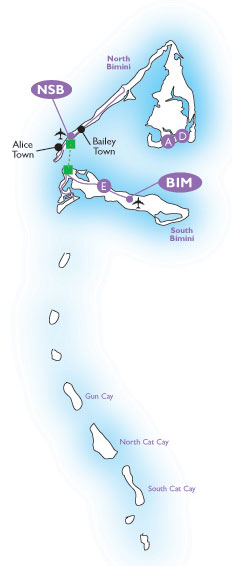 Scientists naturally look askance at psychic information – if, that is, they are even aware of
it. So, the authors observe, the readings were not used to guide archaeologic explorations over past
decades. Consider, too: Turn back the clock beyond 4,000 B.C. and most scholars, especially
those in Cayce’s day, believe it was a time of primitive cultures. The readings, however, give
accounts of Atlanteans, described as a technologically advanced people, having migrated to Egypt –
and other locales – over 12,000 years ago. Also, “the readings mention [human] ancestors as far
back as 10 million years ago, and high civilizations 200,000 years ago.” Remains unearthed in
recent years and carbon dated are adding more credence to the psychic revelations.
Scientists naturally look askance at psychic information – if, that is, they are even aware of
it. So, the authors observe, the readings were not used to guide archaeologic explorations over past
decades. Consider, too: Turn back the clock beyond 4,000 B.C. and most scholars, especially
those in Cayce’s day, believe it was a time of primitive cultures. The readings, however, give
accounts of Atlanteans, described as a technologically advanced people, having migrated to Egypt –
and other locales – over 12,000 years ago. Also, “the readings mention [human] ancestors as far
back as 10 million years ago, and high civilizations 200,000 years ago.” Remains unearthed in
recent years and carbon dated are adding more credence to the psychic revelations.
First published in 1988, this second release of Mysteries of Atlantis Revisited includes an update of discoveries made during the past ten years. Subtle clues and indications seem to be leaning in favor of the Cayce account, but these three writers make no claims. Apparently they are still waiting until all the facts are in.
Cayce readings continued; 11,400 BP, Most of Atlantis sinks, the 'chosen' people move to inland India/Egypt/Syria. Others move to North and South America 10,600 BP. Ra accompied by Enoch enter Egypt, the Great Pyramid is built in 10,390 BP, to preserve the records, 11,600 BP, final sinking of Atlantis.The Babylonian clay tablet map described here has been the generally accepted as the "earliest known map", another contender might be the cartographic artifact found in 1963 by James Mellaart in Ankara, Turkey during an excavation of Catal Hyük in Anatolia. While less distinctive and on a much larger scale, this unearthed map-form is a wall painting that is approximately nine feet long and has an in situ radiocarbon date of 6,200 + 97 B.C. Mellaart believes that the map depicts a town plan, matching Catal Hyük itself, showing the congested "beehive" design of the settlement and displaying a total of some 80 buildings.
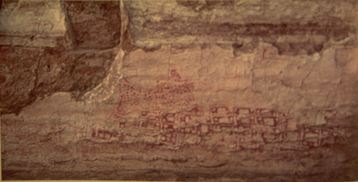 One illustration of this map shows the painting from the north
and east walls of the shrine. In the foreground is a town
arising in graded terraces closely packed with rectangular
houses. Behind the town an erupting volcano is illustrated, its
sides covered with incandescent volcanic bombs rolling down the
slopes of the mountain. Others are thrown from the erupting cone
above which hovers a cloud of smoke and ashes. The twin cones of
the volcano suggest that an eruption of Hasan Dag, rising to a
height of 10,672 feet, and standing at the eastern end of the
Konya Plain and visible from Catal Hyük, is recorded here.
These local volcanic mountains were important to the inhabitants
of Catal Hyük as a source of obsidian used in the making of
tools, weapons, jewelry, mirrors and other objects. Further,
from graphic embellishments around the mountain, Mellaart has
speculated that the depiction of the volcano in an active state
is accurate since vulcanism in this area continued for some
4,000 years later.from...
One illustration of this map shows the painting from the north
and east walls of the shrine. In the foreground is a town
arising in graded terraces closely packed with rectangular
houses. Behind the town an erupting volcano is illustrated, its
sides covered with incandescent volcanic bombs rolling down the
slopes of the mountain. Others are thrown from the erupting cone
above which hovers a cloud of smoke and ashes. The twin cones of
the volcano suggest that an eruption of Hasan Dag, rising to a
height of 10,672 feet, and standing at the eastern end of the
Konya Plain and visible from Catal Hyük, is recorded here.
These local volcanic mountains were important to the inhabitants
of Catal Hyük as a source of obsidian used in the making of
tools, weapons, jewelry, mirrors and other objects. Further,
from graphic embellishments around the mountain, Mellaart has
speculated that the depiction of the volcano in an active state
is accurate since vulcanism in this area continued for some
4,000 years later.from... The Earliest Known Map DATE: 6,200 B.C.
The people of the 4th ( present )epoch
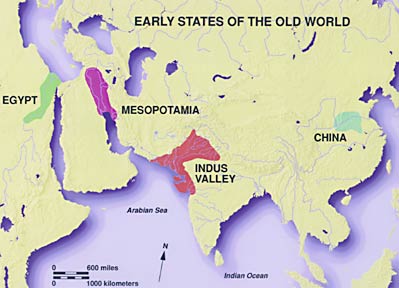 Archaeological discoveries have found more evidence of
'other people' in the area of Sumer. They were; Amorites, Aramaeans,
Elamites, and Kassites. Later there were Lulubaeans and Mitanni
and the Hittites also introduced their dialects into the area.
This means there had to be thousands of years between Noah and
the population of Babylon and the surrounding areas, or
there were 'other' survivors other than Noah's sons. A full
discussion of the culture, including Nimrod's era, is on Passage
page 6 in the series.
Archaeological discoveries have found more evidence of
'other people' in the area of Sumer. They were; Amorites, Aramaeans,
Elamites, and Kassites. Later there were Lulubaeans and Mitanni
and the Hittites also introduced their dialects into the area.
This means there had to be thousands of years between Noah and
the population of Babylon and the surrounding areas, or
there were 'other' survivors other than Noah's sons. A full
discussion of the culture, including Nimrod's era, is on Passage
page 6 in the series.
The map above shows evidence of more than one race of humans being in existance at the same time. Edgar Cayce gives a reading that declares there were 5 races created at the same time. This area on the map shows, the races of caucasian, black and Chinese. Not shown on this map would be the Americas and Atlantis were the "red race" was or the area where the 'brown' race was.
Cayce's words; In the period, then -- some hundred,
some ninety-eight thousand years before the entry of Ram
into India -- there lived in this land of Atlantis one Amilius,
who had first noted that of the separations of the beings as
inhabited that portion of the earth's sphere or plane of those
peoples into male and female as separate entities, or
individuals. One in the white, another in the brown, another
in the black, another in the red. We do not have
any information on the '5th' race or which one
'brown' is as yet. The Enuma Elish tablets say the 'red' race
was created first.
Q. Did the appearance of the five races occur simultaneously?
A. "Occurred at once". ..more on the
Atlantis page 2
NEANDERTHAL DNA DIFFERENT FROM HUMANS
DNA extracted from the bones of a Neanderthal man indicates that Neanderthal man did not contribute to the DNA make-up of modern man.
While Neanderthal man is classified by paleo-anthropologists
as human, DNA analysis indicates that Neanderthal men never
directly contributed to the DNA profile of modern man, and this
same DNA evidence also strongly suggests that Neanderthal man
never even interbred with modern man. In other words,
Neanderthal man contributed nothing to the "gene pool" of modern
man.
New York Times Service, July 11, 1997
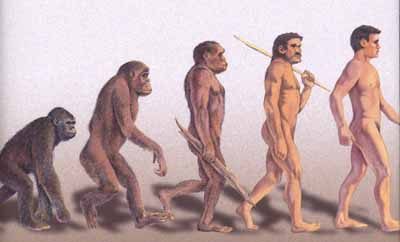 Many students
are convinced of evolution by nothing more than charts like this one.
The order of the line up and brutish restorations reflect more about the
prejudices of the restorer than true scientific evidence. What is the actual,
up to date evidence? What do we know about Australopithicus, Homo Erectus,
Neanderthal and more recent finds? Dr. Patton demonstrates that the fossil
record which supposedly indicates the evolution of man actually represents a
variety of apes and men, not that different from what we see in the living
world. There is nothing in-between but a great deal of imaginative effort and
some pithican-spoofus.
Many students
are convinced of evolution by nothing more than charts like this one.
The order of the line up and brutish restorations reflect more about the
prejudices of the restorer than true scientific evidence. What is the actual,
up to date evidence? What do we know about Australopithicus, Homo Erectus,
Neanderthal and more recent finds? Dr. Patton demonstrates that the fossil
record which supposedly indicates the evolution of man actually represents a
variety of apes and men, not that different from what we see in the living
world. There is nothing in-between but a great deal of imaginative effort and
some pithican-spoofus.
The fossil record is supposed to be the primary documentary evidence for evolution. If there is proof, it would have to be from the fossils. Dr. Patton will examine the evidence, as described by the leading paleontologists themselves, and demonstrate that the supposed proof is very much against evolution. The critical beginning does not show simple, slow, gradual progress . Instead it is sudden, complex and diverse. One by one the supposed links like Archaeopteryx and the American horse series have been "debunked." The imagined progressive continuum from one kind to another is not to be found. There are regular and systematic gaps between the different kinds. See for yourself that the fossil evidence is positive evidence, strongly in favor of the creation model. more see Forbidden knowledge 1
Creation Science is usually defined by the media as the
Genesis account of creation - what is normally taught in the Sunday
School classroom. The charge is continually repeated but it is not true.
Creation science is scientific evidence, not religious dogma. Both
creation and evolution have profound religious, philosophical
implications, yet, both may be investigated scientifically. Chief
Justice Rienquist and Justice Scalla (2004) pointed out that creation science
involved the study of biology, paleontology, genetics, astronomy,
astrophysics, probability analysis and biochemistry. They concluded
that this discipline was the study "of scientific data supporting the
theory that the physical universe and life within it appeared suddenly
and have not changed substantially since appearing...Creation
Science is a strictly scientific concept that...does not require the
presentation of religious doctrine." Many have difficulty imagining
scientific evidence for creation, perhaps because it is zealously
censored from our classrooms. The truth is, there is a great deal
of such evidence..
see Fossil Record
This link promotes the sale of photos of Fossil record and various other
artifacts. We are not endorcing the sale of these items. The link does however
provide a different view of what some call evoluation.
Where was Eden?
The article following, only covers the present epoch and refuses to acknowledge other archaeological findings. One has to 'believe' we are much older before we can except this as fact. Biblical writers only seem to except findings that civilization began 'after Noah's flood', even though the bible describes a civilization that was evil ( or materialistic ) and had to be destroyed. That civilization is recorded as archaeologists 'dig' deeper into our history. This means even our estimates are far short of man's actual time on earth. The man with a 'mind' however (ie. Adam ) may be in the era of 48,000 BC.
Biblical writers commentary: "Ten miles from the sprawling Iranian industrial city of Tabriz, to the northwest of Teheran, says British archaeologist David Rohl, he has found the site of the Biblical garden ..."As you descend a narrow mountain path, you see a beautiful alpine valley, just like the Bible describes it, with terraced orchards on its slopes, crowded with every kind of fruit-laden tree," says Rohl, a scholar of University College, London, who has just returned from his third trip to the area, where mud brick villages flourish today". The Garden of Eden Discovered
Making his case even stronger, Rohl says that he has found the "Land of Nod" which the Bible describes as "East of Eden." Nod was Cain's place of exile after the murder of his brother Abel. Today the area is called "Noqdi."
This we believe isn't Eden, but it is the area settled by Noah's sons, which would have been another Eden like place God chose for them to begin again. The land was rich and well suited for crops and civilizations to grow. His location, 'East of Eden', could have been Africa or even China. On the map above it shows the Indus Valley and China as lands occupied by early humans.
"The Biblical word 'gan' (as in Gan Eden) means `walled garden.’ Rohl continues, "and the valley is indeed walled in by towering mountains." The highest of these is Mt. Sahand, a snow-capped extinct volcano that Rohl identifies as the Prophet Ezekiel’s Mountain of God, where the Lord resides among `red-hot coals’ (Ezekiel 28:11-19)"... But this could also describe what's left of Crete where there would have been a walled city and an active Volcano.
Another point to make here is that Enlil was exiled after he raped a nurse. The Gods expelled him to Africa.
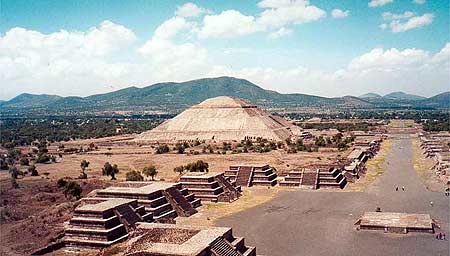 We also have discoveries of the Maya, Aztec and Toltec in a
far distant land. The Maya also built temples
to the Gods. These are still being found in the dense forests of Yucatan.
The Indian God Quetzalcoatl is said to have come from the 'Land of the Rising
Sun'. "He had a beard and wore a long white robe. He taught the people
crafts and laid down the laws. He taught the people how to plant corn
and caused colored bolls of cotton to grow on plants.
The people rejected him after a while so he went to the shore,
and immolated himself in fire and disappeared. It is said
his heart became 'the morning star'. He promised to return
some day."
We also have discoveries of the Maya, Aztec and Toltec in a
far distant land. The Maya also built temples
to the Gods. These are still being found in the dense forests of Yucatan.
The Indian God Quetzalcoatl is said to have come from the 'Land of the Rising
Sun'. "He had a beard and wore a long white robe. He taught the people
crafts and laid down the laws. He taught the people how to plant corn
and caused colored bolls of cotton to grow on plants.
The people rejected him after a while so he went to the shore,
and immolated himself in fire and disappeared. It is said
his heart became 'the morning star'. He promised to return
some day."
In the Sumerian texts we find; When the drainage works carried out in Mesopotamia by Ninurta made cultivation possible in the plains, the Anunnaki “from the mountain the cereal grain they brought down,” and “the Land [Sumerj with wheat and barley did become acquainted.”
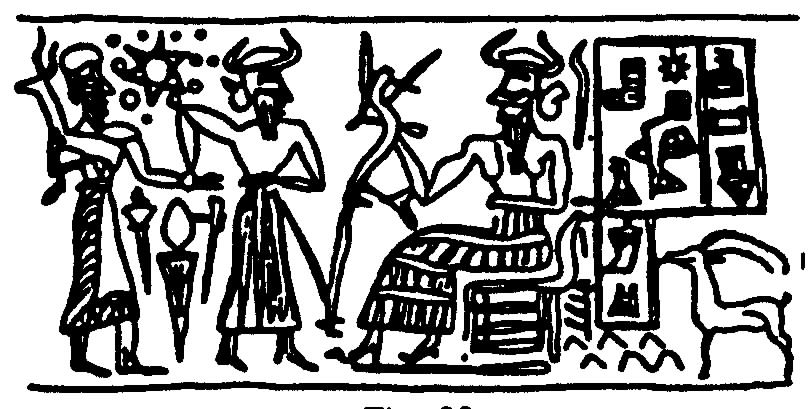 In the millennia that followed mankind revered Ninurta as the one
who had taught it farming; a “Farmer’s Almanac” attributed to him was
actually found by archaeologists in a Sumerian site. The Akkadian name
for him was Urash—’ ‘The One of the Plough”; a Sumerian cylinder seal
depicted him (some believe it shows Enlil) granting the plow to mankind.
In the millennia that followed mankind revered Ninurta as the one
who had taught it farming; a “Farmer’s Almanac” attributed to him was
actually found by archaeologists in a Sumerian site. The Akkadian name
for him was Urash—’ ‘The One of the Plough”; a Sumerian cylinder seal
depicted him (some believe it shows Enlil) granting the plow to mankind.
While Enlil and Ninurta were credited with granting agriculture to mankind, the credit for the introduction of domesticated herds was given to Enki. It was after the first grains were already in cultivation but not yet “the grain that multiplies,” the grains with the doubled, tripled, and quadrupled chromosomes; these were created by Enki artificially, with Enlil’s consent.
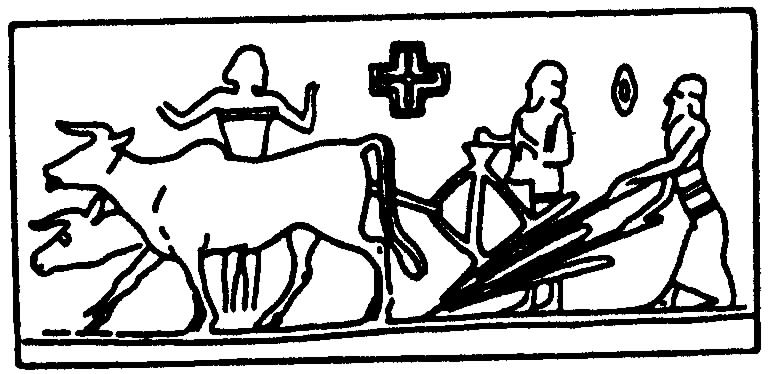 The revolutionaiy agricultural tool-a simple, but ingeniously designed,
wooden implement-the plow, was at first pulled, as the above text states, by
putting a yoke on the farm workers. But then Enki “brought into existence
the larger living creatures” -domesticated cattle and bulls replaced people
as pullers of the plow. Thus, the texts conclude, did the gods “increase
the fertility of the land.”
The revolutionaiy agricultural tool-a simple, but ingeniously designed,
wooden implement-the plow, was at first pulled, as the above text states, by
putting a yoke on the farm workers. But then Enki “brought into existence
the larger living creatures” -domesticated cattle and bulls replaced people
as pullers of the plow. Thus, the texts conclude, did the gods “increase
the fertility of the land.”
While Ninurta was busy damming the mountains flanking Mesopotamia and draining its plains, Enki returned to Africa to assess the damage the Deluge had caused there. As it turned out, Enlil and his offspring ended up controlling all the high ground from the southeast (Elam, entrusted to manna/Ishtar) to the northwest (the Taurus Mountains and Asia Minor, given to Ishkur/Adad), with the highland arching in between given to Ninurta in the south and Nannar/Sin in the north. Enlil himself retained the central position overlooking the olden E.DIN; the Landing Place on the Cedar Mountain was put under the command of Utu/Shamash. Wars of Gods and Men Zacharia Sitchen
The Aztecs were similar to the Sumerians, in that they used their superior
mental abilities to pure power ends. Their mental abilities were supposed to unite
and help the people, instead it corrupted them. They are compared to the Romans
and the Mayans have been compared to the Greeks. The Toltecs were compared
to the Etruscans. The Mayans had a calendar system which
was calculated using the stars and the planets. This calendar is only slightly off the
now used Gregorian calendar by only thousandths of a point. The Aztecs preached
morality and justice. Spanish christians almost wiped them out.
Link to Mayan and Aztec temples
The Cities, the Kings of the New World after the flood
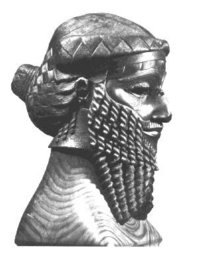 (a´kad, ä´käd), an ancient region of Mesopotamia, occupying
the northern part of later Babylonia. The southern part was
Sumer. In both regions city-states had begun to appear
in the 4th millennium BC. In Akkad a Semitic language,
Akkadian, was spoken. Akkad flourished after Sargon began (c.2340 BC)
to spread wide his conquests, which ranged from his capital, Agade,
also known as Akkad, to the Mediterranean shores. He united city-states
into a vast organized empire. Furthermore, he was overlord of all
the petty states of Sumer and Akkad, as were his successors,
most notably Naramsin. more about Sargon
Forbidden 2
(automatic scroll down).
(a´kad, ä´käd), an ancient region of Mesopotamia, occupying
the northern part of later Babylonia. The southern part was
Sumer. In both regions city-states had begun to appear
in the 4th millennium BC. In Akkad a Semitic language,
Akkadian, was spoken. Akkad flourished after Sargon began (c.2340 BC)
to spread wide his conquests, which ranged from his capital, Agade,
also known as Akkad, to the Mediterranean shores. He united city-states
into a vast organized empire. Furthermore, he was overlord of all
the petty states of Sumer and Akkad, as were his successors,
most notably Naramsin. more about Sargon
Forbidden 2
(automatic scroll down).
In ancient SUMER, the cradle of civilisation, there were 4 leading
gods representing heaven, air, water and earth - Ki/Ninti was the
goddess of the earth (double serpent - also known as Nin-hursag
and she was the wife of both Enlil and Enki.)
She is also known as the mother of the 'living'.
The other three were male, Anu - A god of heaven, Enlil - god of air
and Enki - god of water. Next were the 3 sky deities for the sun
(Sin/Utu the son) and the moon and Venus. The daughter in the EPIC OF GILGAMESH,
was (Ishtar in Mesopotamia/Akkad, Isis in Egypt) - Queen of Heaven and
goddess of love, rain and thunderstorms, procreation and war. Temple
rites were conducted by sacred prostitutes, eunuchs, priestesses, priests,
singers and musicians. 'Ninti' means Lady of the Rib or Lady who Makes
Live (ti meaning rib or to make life) - she is associated
with EVE (Hawwah), Mother of All Creation and Pandora.
So is this where we got Eve from Adam's rib? If it is, the meaning
is mistranslated in the biblical text.
"During the fourth millennium there were major developments
in metallurgy." Objects at Nahal Mishmar "were an alloy of
copper and arsenic, which was easier to cast and harder than
pure copper and was often used before tin or bronze in the second
millennium BC."
"The first use of the plow in the Near East also dates from the
Urik period....Plows, wheels, boats and donkeys were almost
certainly in use before the Uruk period" in Northern Europe.
- Michael Roaf, Cultural Atlas of Mesopotamia
"At a period approximately 3,400 years before Christ, a
great change took place in Egypt, and the country passed rapidly
from a state of Neolithic culture with a complex tribal
character to [one of] will-organized monarchy...
"At the same time the art of writing appears, monumental
architecture and the arts and crafts develop to an astonishing
degree, and all the evidence points to the existence of a
luxurious civilization. All this was achieved within a
comparatively short period of time, for there appears to be
little or no background to these fundamental developments in
writing and architecture."
Walter B. Emery, Archaic Egypt
Since the area near where the Tigris and Euphrates rivers emptied into the Persian Gulf had two dominant groups, the Sumerians and Akkadians, it is often referred to as Sumer-Akkad. As part of an almost endless pattern, other people kept trying to take control of this area's land, mineral resources, and trade routes.
Eventually they succeeded. Semitic Amorites from the Arabian Penninsula gained control over most of Mesopotamia by about 1900 BC. They centralized their monarchical government over the city-state just north of Sumer, in Babylon, the area formerly called Akkad (Agade). The three centuries of their domination is known as the Old Babylonian Period.
Babylonians believed the king held power because of the gods; moreover, they thought their king was a god. To maximize his power and control, a bureaucracy and centralized government were established along with the inevitable adjuncts, taxation and involuntary military service.
The Sumerians already had laws, but they were administered jointly by individuals and the state. With a divine monarch came divinely inspired laws, violation of which was an offense to the state as well as the gods. The Babylonian king (1728 - 1686 BC) Hammurabi codified the laws in which (as distinct from the Sumerian) the state could prosecute on its own behalf. The Code of Hammurabi (see code of Laws) is famous for demanding punishment to fit the crime (the lex talionis, or an eye for an eye) with different treatment for each social class. The Code is thought to be Sumerian in spirit but with a Babylonian inspired harshness.
Hammurabi also united the Assyrians to the north and the Akkadians and Sumerians to the south. Trade with Anatolia, Syria, and Palestine spread Babylonian influence further. He further consolidated his Mesopotamian empire by building a network of roads and a postal system.
In religion, there wasn't much change from Sumer/Akkad to Babylonia. Hammurabi added a Babylonian Marduk, as chief god, to the Sumerian pantheon. The Epic of Gilgamesh is a Babylonian compilation of Sumerian tales about a legendary king of the city-state of Uruk, with a flood story. This is the 'origional flood' story that became known as Noah's flood. It says that the God's had a meeting stating that the population had grown out-of-control and a solution was needed to eliminate them. Thus is the reverse of the Genesis account where the population explodes after the flood.
When in the reign of Hammurabi's son, the horse-back invaders known as the Kassites, made incursions into Babylonian territory, the Babylonians thought it punishment from the gods, but they managed to recover and stayed in (limited) power until the beginning of the 16th century B.C. when the Hittites sacked Babylon, only to withdraw later because the city was too distant from their own capital. Eventually the Assyrians suppressed them, but even that was not the end of the Babylonians for they rose again in the Chaldean (or Neo-Babylonian) era from 612 - 539 made famous by their great king, Nebuchadnezzar. In 539 the Persian king Cyrus invaded. Babylonia remained under Persian rule until the time of Alexander the Great .....
The first ruler to succeed in uniting a large part of Mesopotamia under his scepter, the area ran from Elam to the Tarus Mountains, was Sargon I ( 2360-2305 BC.) The legend of his birth brings to mind Cyrus, Romulus, Krishna, Moses, and Perseus. His mother, a virgin, put him in a container, sealed it with pitch, and set it adrift on a stream. Akki, creator of the waters, raised the foundling to be a gardner, and later the goddess Ishtar made him a king. For a long time it was believed that Sharruken, ( legitimate king, Sargon ) had never really existed. Today the fact has been established that Sargon did live and wield a memorable historical influence. more see Forbidden 2 - Sargon
The merit of Sargonic art can be seen in the stele of Naramsin. The naturalistic sculpture, depicting a wide range of mythological scenes, reflected a high achievement in glyptic art. After more than a century the empire declined and was overrun by mountain tribes. When the Akkadian empire had fallen, Mesopotamia was in chaos. Peace was maintained only in the south in the city-state of Lagash under Gudea. Lagash was later absorbed by the 3d dynasty of Ur, which governed both Akkad and Sumer. Toward the end of the 3d millennium Elam took over most of the power as a new wave of Semitic-speaking peoples entered Mesopotamia. It was by defeating the Elamites that Hammurabi was able to create Babylonia. The name Akkad also appears as Accad. The image;(Baghdad: Iraq Museum). Sargon I (Sharrukin), king of Semitic Agade, created a fully developed absolute monarchy with hegemony over surrounding peoples. from. Akkad
From this area came the epic tale of Gilgamesh. Gilgamesh as we know, is the first recorded history of 'the flood', which we date to 7640 BC. The story was pieced together from thousands of shards found on the mound of Kuyunjik. This area is on the banks of the Tigris river across from Mosul. Layard found these cuneiform lettered bricks in 1849. This area is also known to be where the city of Nineveh ( Tower of Babel ) was located. The Epic of Gilgamesh
Nineveh was the capitol of lands that extended into Syria and
Palestine. In 1700 BC, Hammurabi, the Babylonian lawgiver,
mentioned the Temple of Ishtar around which the city was built.
The tablets proved to be the key to a much older
civilization, who handed down their words in clay. Fragments of
them were dated to 4000 BC.
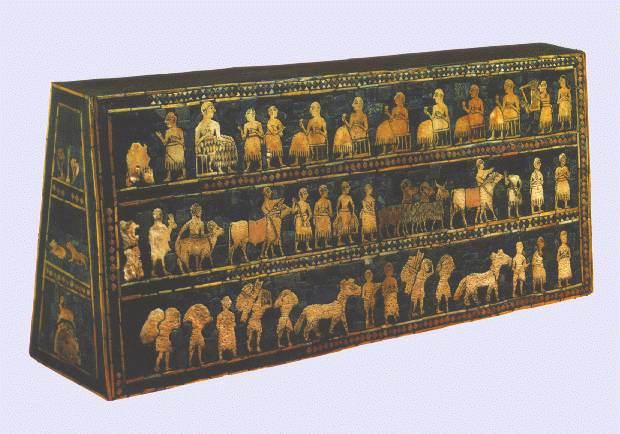 Leonard Woolley dug in the biblical city of Ur of Chaldea and
confirmed the flood was of historical record there also. He
found a mosaic called "the standard of Ur."
He dated this to 3500 BC. It showed row upon row of tiny figures
fashioned of mother of pearl and mussel shell, inlaid with lapis
lazuli in asphalt on a wood base.
Leonard Woolley dug in the biblical city of Ur of Chaldea and
confirmed the flood was of historical record there also. He
found a mosaic called "the standard of Ur."
He dated this to 3500 BC. It showed row upon row of tiny figures
fashioned of mother of pearl and mussel shell, inlaid with lapis
lazuli in asphalt on a wood base.
That means the flood was before 4000 BC as a culture had already developed and had 'began again'. The city of Ur lay thirty-eight feet under ground in a layer of ashes, decayed brick, clay shards, and rubbish. The headdress of Queen Shub-ad was found in a grave along with silver and copper boats and gold vessels. That means that art forms of real quality existed 5000 years BC. The link above to David Rohl's discoveries, also says the cuneiform tablets held by the Museum of the Orient in Istanbul, describe a 5000 year old route to Eden. If you add that to 5000BC, which is the date of the Sumerian priest-king of Uruk, you go back to before Noah's flood, the date of Enoch's time in earth and the building of the Great Pyramid.( 10,390 BC ).
 Woolley found a limestone foundation tablet, with an inscription on it
in cuneiform writing confirming the dedication of a temple. This temple was
dedicated to the mother goddess Nin-Khusrag. The dedication was by
"A-anni-padda, King of Ur, son of Mes-anni-padda, King of Ur.
Mes-anni-padda appeared in the king lists as the founder of the
third dynasty after the flood, that is at the head of the first
dynasty of Ur. This king had been considered
mythical and this find proved him real and historical.
Abraham's Grandfather was also a king of Ur.
Woolley found a limestone foundation tablet, with an inscription on it
in cuneiform writing confirming the dedication of a temple. This temple was
dedicated to the mother goddess Nin-Khusrag. The dedication was by
"A-anni-padda, King of Ur, son of Mes-anni-padda, King of Ur.
Mes-anni-padda appeared in the king lists as the founder of the
third dynasty after the flood, that is at the head of the first
dynasty of Ur. This king had been considered
mythical and this find proved him real and historical.
Abraham's Grandfather was also a king of Ur.
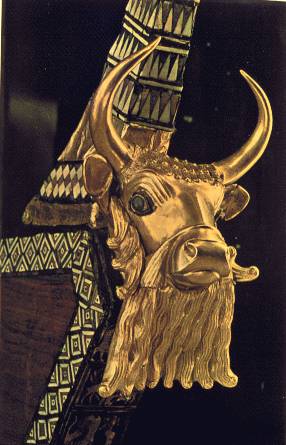 The temple was equipped with stairs, terraces, vestibule,
and wooden columns inlaid with copper. It also contained rich
mosaics, showing sculptured lions and deer. It was one of the
oldest pieces of construction in the world in which notable
size was coupled with artistic handling. Woolley also found a
golden bead.
The temple was equipped with stairs, terraces, vestibule,
and wooden columns inlaid with copper. It also contained rich
mosaics, showing sculptured lions and deer. It was one of the
oldest pieces of construction in the world in which notable
size was coupled with artistic handling. Woolley also found a
golden bead.
Final proof of much older origins come in the layer of clay found another forty feet down. This layer was 8.2 feet thick and he says, recorded the actual flood. If thirty eight feet is equal to 5000 years, how long is the period of yet another forty feet? We think it is equal to another 6,400 years and coincides with the Vesuvius eruption. This equals 147 to 152 feet of earth layer per thousand years.
This article backs up our theory; WASHINGTON, Nov. 18 — The biblical story of Noah and the great flood inspired this engraving by Gustave Dore, titled "Dove Sent Forth From the Ark." Now scientists say they have found new evidence for a catastrophic flood thousands of years ago. Scientists have discovered an ancient coastline 550 feet below the surface of the Black Sea, providing dramatic new evidence of a sudden, catastrophic flood around 7,500 years ago—the possible source of the Old Testament story of Noah. A TEAM of deep-sea explorers this summer captured the first sonar images of a gentle berm and a sandbar submerged undisturbed for thousands of years on the sea floor. Now, using radiocarbon dating techniques, analysts have shown that the remains of freshwater mollusks subsequently dredged from the ancient beach date back 7,500 years and saltwater species begin showing up 6,900 years ago. see "New evidence of ancient flood"
The findings offer independent verification of a theory advanced by Columbia University geologists William Ryan and Walter Pitman that the Black Sea was created when melting glaciers raised the sea level until the sea breached a natural dam at what is now the Bosporus, the strait that separates the Mediterranean Sea from the Black Sea. Ryan and Pitman also suggested that the flood may have triggered massive migrations to destinations as diverse as Egypt, western Europe and central Asia, an idea that has provoked some academic controversy. Shanks pointed out that biblical scholars date the writing of the Book of Genesis, from which the story of Noah is taken, at sometime between 2,900 and 2,400 years ago, and a similar event is described in the Mesopotamian Gilgamesh legend, written about 3,600 years ago. The findings described here, prove this to be correct. But you then have a time span of 7,000 years before the writing took place which leaves us with the possibility of misinterpretation and corrections that lost the truth.
Hundreds of stories about "the Flood".. see Flood from all over the world. exerpt; An earlier flood was reported to have occurred in the time of Ogyges, founder and king of Thebes. The flood covered the whole world and was so devastating that the country remained without kings until the reign of Cecrops. "Many great deluges have taken place during the nine thousand years" since Athens and Atlantis were preeminent. Destruction by fire and other catastrophes was also common. In these floods, water rose from below, destroying city dwellers but not mountain people. The floods, especially the third great flood before Deucalion, washed away most of Athens' fertile soil. [Plato, "Timaeus" 22, "Critias" 111-112]
More early artifacts
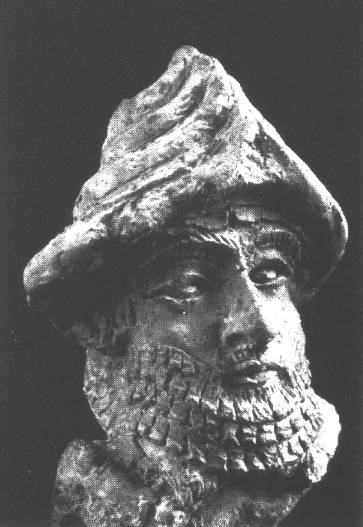 A Baked clay head of a god from Telloh, c. 2000 B.C. The god wears the
triple crown of divinity. It is in Le Louvre, Paris. This triple crown
was also worn by the early Pope's.
A Baked clay head of a god from Telloh, c. 2000 B.C. The god wears the
triple crown of divinity. It is in Le Louvre, Paris. This triple crown
was also worn by the early Pope's.
There are two serpentine symbols associated with medicine today, the staff of Aesculapius and the Cadeuceus, although the staff of Aesculapius has the strongest mythological association to healing. Aesculapius was a Roman physician who was such a skilled healer that he became a god, and temples were dedicated to him. The symbol of his wooden staff with only one snake coiled around it was adopted by the American Medical Association early last century.
 The Cadeuceus
is a figure that consists of two entwined
serpents encircling a wand or rod. It was carried by Hermes in
Greek myths and Mercury in Roman mythology as the messenger
of the gods. It was a symbol of authority and protected the
herald who carried it.
The Cadeuceus
is a figure that consists of two entwined
serpents encircling a wand or rod. It was carried by Hermes in
Greek myths and Mercury in Roman mythology as the messenger
of the gods. It was a symbol of authority and protected the
herald who carried it.
The similarity of this symbol to the double helix of DNA strands is a common observation. By looking at Greek myths we can find links to cataclysms and re-creation...
The Cadeuceus has a slightly more ancient background and, more importantly, it reinforces our links between floods, DNA and serpents/dragons.
Hermes/Thoth appears to be the same character as Quetzalcoatl/Kulkulcan/Nahuatl of Mesoamerica. The both had serpent imagery (Quetzalcoatl was a feathered serpent, Hermes wore a winged hat and sandals and carried the Cadeuceus) and each provided similar services to their people (Quetzalcoatl cured ailments, introduced corn, science, calendars, created fire and gave instruction of music and dance). Another mythical cousin to these two is Buddha. Also a great teacher, he had a virgin mother named Maya.
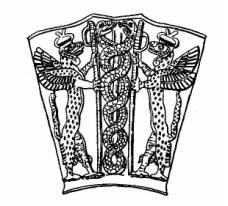 Although this symbol
is most famous for being carried by Hermes, we can
trace it back to a much earlier civilization. On exhibit in the Louvre is
a green libation vase, which was excavated from the ancient Mesopotamian
city of Lagash. The inscription on it, from King Gudea of
Lagash circa 2025 BC, is a dedication to Ningizzida. Also on the
vase is an image of two entwined snakes on a rod. Some have
dated the vase as far back as 4000 B.C. The rod is most likely
to be Axis Mundi, the world tree, Yggdrasil, the tree of life.
Ningizzida, a fertility god, was also known as 'Lord of the
Tree of Life'. He was often depicted as a serpent with a human
head, and later became a god of healing and
magic. His companion was Tammuz/Dumuzi, who personified the
creative powers of spring (like the Greek Maia). see..
DNA and the I Ching
Although this symbol
is most famous for being carried by Hermes, we can
trace it back to a much earlier civilization. On exhibit in the Louvre is
a green libation vase, which was excavated from the ancient Mesopotamian
city of Lagash. The inscription on it, from King Gudea of
Lagash circa 2025 BC, is a dedication to Ningizzida. Also on the
vase is an image of two entwined snakes on a rod. Some have
dated the vase as far back as 4000 B.C. The rod is most likely
to be Axis Mundi, the world tree, Yggdrasil, the tree of life.
Ningizzida, a fertility god, was also known as 'Lord of the
Tree of Life'. He was often depicted as a serpent with a human
head, and later became a god of healing and
magic. His companion was Tammuz/Dumuzi, who personified the
creative powers of spring (like the Greek Maia). see..
DNA and the I Ching
How Old are we really?
Egyptologists focus on 3100 BC and the "Scorpion" Dynasty as being the oldest. The King identified with this dynasty is Menes. Other evidence we find in Egyptian culture is not dated any farther back than 5500 BC to 3800 BC, but there are other details and objects that date the culture much farther back in time. Egyptologists are slow in revealing these details. The first of the pre dynastic cultures of Egypt in Upper Egypt, that is that part of Egypt south of modern Cairo, was the so-called BADARIAN, named after the type-site of el-Badari near Asyut. The BADARIAN period is roughly dated by the Carbon 14 method and by thermoluminescence dating from 5500 BC to 3800 BC.
We seem to have only two recognized written forms of dating the old dynasties. One, that it begins with an enumeration of gods, demigods, spirits and mythical beings that were supposed to have ruled Egypt before the reign of Menes. It was not a cultic list and it does not serve the purpose of showing the current king as the good heir to his "ancestors". It is broken into over 160 often very small fragments, many of which have been lost. When it was discovered in the Theban necropolis by the Italian traveler Bernardino Drovetti in 1822, it seems to have been largely intact, but by the time it became part of the collection of the Egyptian Museum in Turin, its condition had severely deteriorated.
A king list written on papyrus from the New Kingdom is in
the Turin Museum.
"Originally it listed around 300 names of kings, and the aim of
its compiler was completeness. No king seems to have been too
minor or sort-reigned for inclusion. the Palestinian kings who
formed the Hyksos Dynasty were included, even though they did not
merit having heir names written in cartouches. This, in fact,
was a remarkable concession to reality: tacitly admitting a
break in the succession of legitimate kings just for the purpose
of attaining completeness. Against each king in the Turin list
was written the precise length of his reign, sometimes to the
exact day. At certain points a summary of numbers of kings and
total length of reigns was inserted. Thus at the end of what we
now the 8th Dynasty, a summary of 958 years, from the reign of
King Menes, the first name of the lists, was provided."
"Immediately before Menes came several lines which summarize the
collective reigns of 'spirits', not given individual names, and
before these, and heading the whole compilation, a list of
deities. The name of each is written in a cartouche, as if a
king, and followed by a precise length of reign. In the case of
the god Thoth, for example, this is 7,726 years."
- Jean-Philipe Lauer, Saqqara
The papyrus now 1.7m long and 0.41m wide , comprises
on the recto an unknown number
of pages that hold a list of names of persons and institutions,
along with what
appears to be the tax-assessment of each. However the papyrus
is missing it's first part.
This is what remains;
I,x - I,21: Ptah and the Great Ennead
I,22 - II,3 : Horus and the Lesser Ennead (?)
II,4 - II,8 : the spirits
II,9 : a mythical group of kings
II,10 : another group of mythical kings (?)
from.. The Turin Cannon
Another source gives the so-called mythical kings names Turin Papyrus then click Transcription I. You will find on this list the names of the 'Gods' which are written matching the Sumerian names for the planets.
The other source is named after the Horus Narmer,
whose titulary appears on both its faces, the Narmer
Palette is a flat plate of schist of about 64 centimeters in height.
Its size, weight and decoration suggest that it was a ceremonial palette,
rather than an actual cosmetics palette for daily use.
It was found in Hierakonpolis, the ancient Pre-Dynastic capital located in the south
of Egypt, by the British archaeologist J.E. Quibell during the excavation season of 1897/98,
in a deposit, along with other artifacts stemming from the early beginnings of the recorded
history of Ancient Egypt: Fragments of a ceremonial mace head belonging to Narmer and
some other mace head fragments inscribed with the name of the Horus.
The Narmer Palette
and Narmer 1 The reverse side and..
Narmer 2
Of a hieroglyphic drawn on the palatte, it is said, "Their reading is
unknown so even if they do denote names of places, we do not
know which places they are. In light of the symbolic
representation of a marshland in the main scene of the palete
(see above), it is not unlikely that these two places were located in the Nile
Delta." But 10,000 years previous, there was marsh land in the Nile valley.
The period of Narmer, follows the Scorpion dynasty according to Egyptologists.
How could science determine the true age of a stone monument? Nobody can
correctly date rock, so how old is it really? Another explanation to Narmer dating..
New Date
Note: Mace was only known to be grown on the North American
continent and was supposedly discovered by Christopher Columbus.
We have proof he did not discover America.( see Knights Templar )
Archaic Period .. I Dynasty
It is clear from the content of the inscriptions in the pyramid of Unas, that many of the utterances had been in existence for centuries. Spell 662 tells the dead king to cast the sand from his face, which seems to allude to burial in the desert sand as practiced in the pre dynastic period. Spell 355 says that the bricks have been removed from the tomb, and must refer to the mud brick mastabas of the Archaic Period.
But we have something much older, The Emerald Tablets of Thoth. The words are written on the substance known in Masonic legend as Laterus but now are known as 'emerald', somewhere around 36,000 - 38,000 BC. The substance is not reproducible in modern science. It is a hard gem quality material that is opaque. Some now call it glass. We believe this to be incorrect.
This will astound you..
Dawn of Time to the Present.
400,000,000 BC -- Shoe print made in Pershing Co, Nevada
which clearly shows fine stitching. See Sphinx Group. or Liber
Chronos. A shoe crushing a trilobite in Antelope Spring, Utah.
300,000,000 BC -- Ed Conrad, an amateur archaeologist,
finds humanoid fossil skulls in coal beds in Pennsylvania.
He also finds leg bone fragments.
60,000,000 BC -- In the Peru desert Ocucaje, Dr. Javier
Cabrera discovers 40,000-50,000 rock engravings which show
step-by-step a heart transplant and Caesarian section surgery.
They also showed dinosaurs and men riding them. These men were
shorter and had larger heads than modern man. These are called
the Ica Stones of Peru. Human footprints found in same layer
as dinosaur prints in Glen Rose, Texas. More on Glen Rose.
These were called "giant man tracks" and would seem to coincide
with the bible's mention of the fallen angles being large size
and roaming the earth in the times of Noah. And this coinsides
with the image of the large-headed man you saw on Passage forward 3.
Large men were also mentioned when Moses led the
Israelites to Canaan. This date agrees
with our own theory that Moses left Egypt around 1510
BC and arrived in Israel in 1456 BC..
Compair what we now know with what biblical writers tell us.
The Earth has four corners. (Isa. 11: 12*)
From the above it has been presumed that the Earth is flat.
The Sun moves around the Earth (Josh. 10: 13*)
And from the above it is presumed the Earth is at the centre of
the Universe.
One of the main reasons why the various religions and their adherents have stridently opposed the proposition that evolution has been involved with the creation process is solely because of their rudimentary understanding of the scripture. Therefore they maintain that the seven 'days' of creation, as given in the Genesis account, are of the literal 24 hour variety. They also maintain that Biblical chronology will not allow for this event to have taken place any earlier than 6000 years ago! And they do this in the same way that their 'spiritual' predecessors demanded that the earth had four corners and that the earth itself was flat.
As the laws of the natural creation has been gradually unraveled by such persons as Copernicus, Kepler, Galileo, Newton etc., so the biblical fundamentalists have had to make a steady retreat in their assertions (and interpretations). Not that they have been able to give any real explanations for why they have insisted the scripture has only been written in the literal terms on which they have based their conclusions. And their retreat has usually been a very reluctant one, to say the least, and mostly done in bad grace. In fact, it has only been in the last few years (1996) that the Pope has gone so far as to admit to the injustices his organization had perpetrated on Galileo at the time of the Inquisition - and all of which, it should be remembered, was perpetrated in the name of God (Truth)!
And once again the Pope has now been forced to admit to the validity of the process of evolution even though he would subject it to certain limitations.
Yet, these persons, in spite of having gone from pillar to post in retreating from their man-made doctrines, show no sign of questioning their own rationality or competence. For the Creationists (Literalists) are right up front and strident with their assertions that the Genesis account of the days of creation is all to be taken literally, in exactly the same way as they demanded for their previous erroneous conclusions.
Any suggestion that the account in Genesis has an allegoric content is usually rejected out of hand, with the same arrogance that their predecessors had in their rejection of any opposition to the literalities quoted above (like with a flat earth). Consequently, the net result of their actions has been to bring the reputation of the scripture into ill-repute today. That this is the case should not be at all surprising for the scriptures had already predicted that such a situation would arise (2 Peter 2: 1, 2*).
What is being stated by the evolutionist, and by those persons who observe nature, is that the way our earth has been created is written in the footprints of time. And in adhering to the scriptural principle stated in Rom. 1: 20*, they have naturally been forced to the conclusion that the earth has evolved gradually over a considerable period of time. The fossil records alone detailing this position are indeed impressive and overwhelming for those who have eyes to see, apart from other scientific evidence pointing to the same conclusion.
Consequently, the Creationist's whole premise has to centre around the question as to whether the Genesis account of the scripture is literal or allegoric, and if it is allegoric how literal is its analogies? The true Evolutionist, unlike the Creationist, has no problems with what nature is saying, or the Biblical account for that matter, but merely with the interpretations the Creationists wish to place upon that account.
The allegoric content of Genesis in general terms is made quite clear from the above mentioned explaination, and it is the kernel construction of the Bible which demands that Genesis have this allegorical content. The scriptural proof for the linkage between these two patterns in allegoric terms is given at Hebrews 4: 4-9* where it specifically links the two types of the day of rest (Sabbaths). Also the text at 2 Pet. 3: 8* vouches for the interchangeability of the values applying to a 'day' as required by the scriptures' coded language. And once the validity of the information in Genesis as being allegoric is proven, any demands for a literal interpretation of those texts should be automatically brought into question, and that is because it should be manifest that one is dealing with the hidden languages of the scripture.
It is those who wrest the import of the Bible's information out of its proper context who create the problems (2 Peter 3: 16*), which in turn results in the Bible's integrity being brought into question. It is the Creationist's presumptions that have put the credibility of the Bible on the line, not those of the Evolutionist. The Evolutionist's manifest desire is to get at the truth of the matter, but he usually finds that the Creationist is not willing to have his view of 'truth' disturbed or questioned in any way, leave alone that he should listen to reason!
Allegorical lessons were also taught by Jesus. That is the main reason the literalists cannot interrupt scripture correctly. Many things he said are not literal by meaning. However some are and the litertalists missunderstood those too.
continued on.. Genesis redefined
View My Guestbook
 Sign My Guestbook
Sign My GuestbookNO PART OF THIS SITE MAY BE COPIED OR REPRODUCED, IN WHOLE OR IN PART, WITHOUT THE EXPRESS WRITTEN PERMISSION OF THE WEBMASTER... © COPYRIGHT 1999 - 2009 C.I.C. ALL RIGHTS RESERVED.
If your site is not Strictly Masonic in nature, We
kindly ask that you do not link to this site
without permission of the Web Master or under the guidelines set forth here...
see Legal Issues
This page has been visited times since November 31, 1999